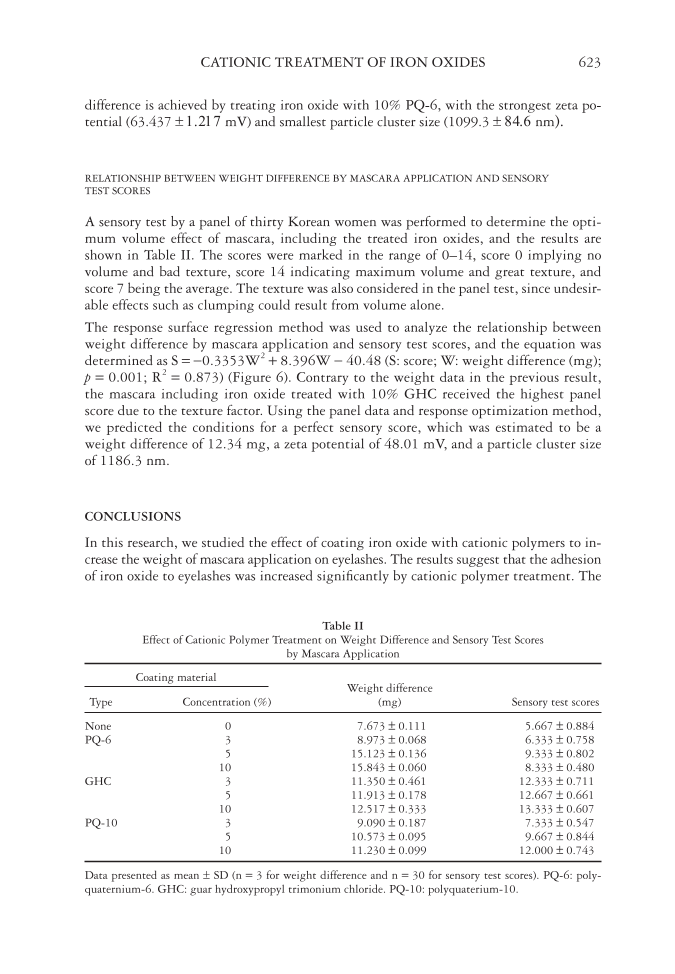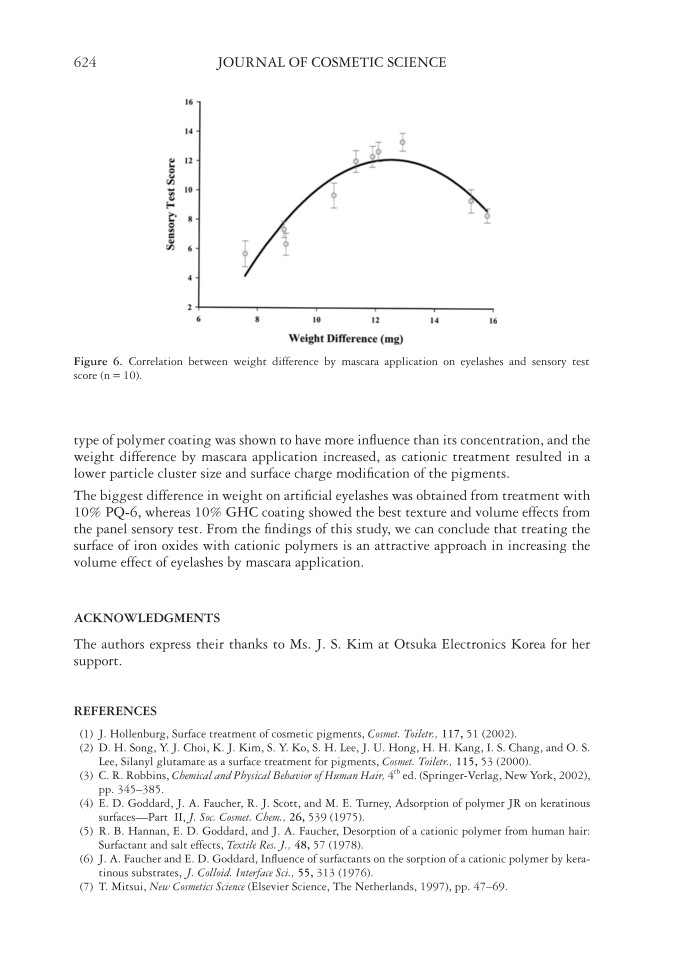CATIONIC TREATMENT OF IRON OXIDES 623 difference is achieved by treating iron oxide with 10% PQ-6, with the strongest zeta po- tential (63.437 ± 1.217 mV) and smallest particle cluster size (1099.3 ± 84.6 nm). RELATIONSHIP BETWEEN WEIGHT DIFFERENCE BY MASCARA APPLICATION AND SENSORY TEST SCORES A sensory test by a panel of thirty Korean women was performed to determine the opti- mum volume effect of mascara, including the treated iron oxides, and the results are shown in Table II. The scores were marked in the range of 0–14, score 0 implying no volume and bad texture, score 14 indicating maximum volume and great texture, and score 7 being the average. The texture was also considered in the panel test, since undesir- able effects such as clumping could result from volume alone. The response surface regression method was used to analyze the relationship between weight difference by mascara application and sensory test scores, and the equation was determined as S = −0.3353W2 + 8.396W − 40.48 (S: score W: weight difference (mg) p = 0.001 R2 = 0.873) (Figure 6). Contrary to the weight data in the previous result, the mascara including iron oxide treated with 10% GHC received the highest panel score due to the texture factor. Using the panel data and response optimization method, we predicted the conditions for a perfect sensory score, which was estimated to be a weight difference of 12.34 mg, a zeta potential of 48.01 mV, and a particle cluster size of 1186.3 nm. CONCLUSIONS In this research, we studied the effect of coating iron oxide with cationic polymers to in- crease the weight of mascara application on eyelashes. The results suggest that the adhesion of iron oxide to eyelashes was increased signifi cantly by cationic polymer treatment. The Table II Effect of Cationic Polymer Treatment on Weight Difference and Sensory Test Scores by Mascara Application Coating material Weight difference (mg) Sensory test scores Type Concentration (%) None 0 7.673 ± 0.111 5.667 ± 0.884 PQ-6 3 8.973 ± 0.068 6.333 ± 0.758 5 15.123 ± 0.136 9.333 ± 0.802 10 15.843 ± 0.060 8.333 ± 0.480 GHC 3 11.350 ± 0.461 12.333 ± 0.711 5 11.913 ± 0.178 12.667 ± 0.661 10 12.517 ± 0.333 13.333 ± 0.607 PQ-10 3 9.090 ± 0.187 7.333 ± 0.547 5 10.573 ± 0.095 9.667 ± 0.844 10 11.230 ± 0.099 12.000 ± 0.743 Data presented as mean ± SD (n = 3 for weight difference and n = 30 for sensory test scores). PQ-6: poly- quaternium-6. GHC: guar hydroxypropyl trimonium chloride. PQ-10: polyquaterium-10.
JOURNAL OF COSMETIC SCIENCE 624 type of polymer coating was shown to have more infl uence than its concentration, and the weight difference by mascara application increased, as cationic treatment resulted in a lower particle cluster size and surface charge modifi cation of the pigments. The biggest difference in weight on artifi cial eyelashes was obtained from treatment with 10% PQ-6, whereas 10% GHC coating showed the best texture and volume effects from the panel sensory test. From the fi ndings of this study, we can conclude that treating the surface of iron oxides with cationic polymers is an attractive approach in increasing the volume effect of eyelashes by mascara application. ACKNOWLEDGMENTS The authors express their thanks to Ms. J. S. Kim at Otsuka Electronics Korea for her support. REFERENCES (1) J. Hollenburg, Surface treatment of cosmetic pigments, Cosmet. Toiletr., 117, 51 (2002). (2) D. H. Song, Y. J. Choi, K. J. Kim, S. Y. Ko, S. H. Lee, J. U. Hong, H. H. Kang, I. S. Chang, and O. S. Lee, Silanyl glutamate as a surface treatment for pigments, Cosmet. Toiletr., 115, 53 (2000). (3) C. R. Robbins, Chemical and Physical Behavior of Human Hair, 4th ed. (Springer-Verlag, New York, 2002), pp. 345–385. (4) E. D. Goddard, J. A. Faucher, R. J. Scott, and M. E. Turney, Adsorption of polymer JR on keratinous surfaces—Part II, J. Soc. Cosmet. Chem., 26, 539 (1975). (5) R. B. Hannan, E. D. Goddard, and J. A. Faucher, Desorption of a cationic polymer from human hair: Surfactant and salt effects, Textile Res. J., 48, 57 (1978). (6) J. A. Faucher and E. D. Goddard, Infl uence of surfactants on the sorption of a cationic polymer by kera- tinous substrates, J. Colloid. Interface Sci., 55, 313 (1976). (7) T. Mitsui, New Cosmetics Science (Elsevier Science, The Netherlands, 1997), pp. 47–69. Figure 6. Correlation between weight difference by mascara application on eyelashes and sensory test score (n = 10).
Purchased for the exclusive use of nofirst nolast (unknown) From: SCC Media Library & Resource Center (library.scconline.org)

































































































